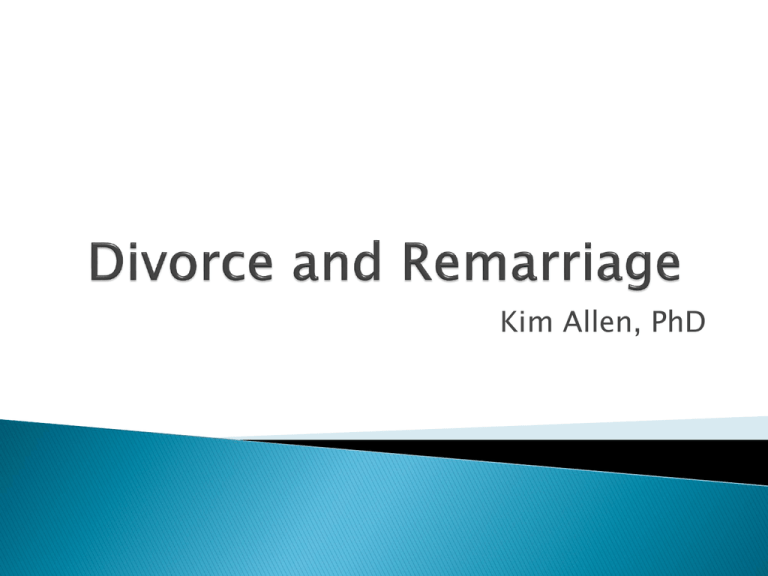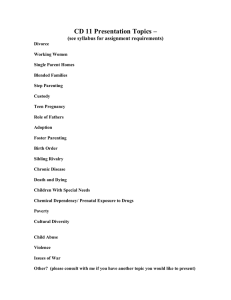Kim Allen, PhD
advertisement

Kim Allen, PhD Poor communication Financial problems A lack of commitment to the marriage A dramatic change in priorities Infidelity Failed expectations or unmet needs Addictions and substance abuse Physical, sexual or emotional abuse Lack of conflict resolution skills The The The The The Published aul Bohannan (1970), legal divorce — emotional divorce — economic divorce — co-parental divorce — community divorce — Set aside time to meet as a family Plan ahead of time what to tell children Stay calm Plan to meet again 1. Avoid criticizing the other parent in front of the children. 2. Avoid arguing in front of the children—discuss coparenting issues when children are not present. 3. Plan how pick-up & drop-off will take place and follow the plan, but be willing to change the plan if needed. 4. Reassure children that conflict and divorce are not their fault. 1. Avoid using the child as a messenger—discuss parenting and financial issues directly. 2. Have a plan for dealing with the child’s unexpected expenses. 3. Avoid discussing child support issues with children. 4. Update the parenting plan as children’s needs change. 1. You will not be replaced if you stay involved in your child’s life. 2. Avoid asking questions that make children feel like spies. 3. Avoid using parenting time as leverage or a way to try to control the other parent. 4. Consider what role potential new partners should have in the lives of your children before bringing a new partner into the child’s life. 1. Make time for yourself when children are with the other parent. 2. Transitioning between households is stressful for children. A routine with built-in “down time” helps. 3. Differences between households are to be expected. It is impossible to control what happens in the other parent’s household. 4. Children need to feel loved and have consistent routines and responsibilities in each household. Clear, non defensive communication Use "I" statements Patient listening Plan what you are going to say next Understanding and mutual respect Stay Calm Many stepfamilies are born of loss (divorce, death, separation). Stepfamily members may be dealing with unresolved grief. Children grieve the loss of their first family, even if there were a lot of problems. Stepfamilies are not always formed after a death or divorce. Some stepfamilies are formed when a never-married parent marries a new partner who is not the biological parent of the child. Each family is coming to the stepfamily with its own history, routines, and traditions. Children are often members of two households It generally takes 4-7 years for a stepfamily to stabilize. Children are especially likely to experience loyalty conflicts when a parent is not supportive of the child's relationship with the stepparent or vice versa Stepparent-stepchild relationships go more smoothly when the stepparent acts as a friend, rather than a parent toward the stepchild in the beginning and supports the biological parent. Family transitions are difficult for both younger and older children Stepparents do not automatically have legal rights to authorize medical care or have access to school records, among other rights All materials for this Power Point came from the University of Missouri Extension Publications, including: GH6600, Helping Children Understand Divorce GH6602, Dealing With Divorce: A Guide to Coping Activities for Children


